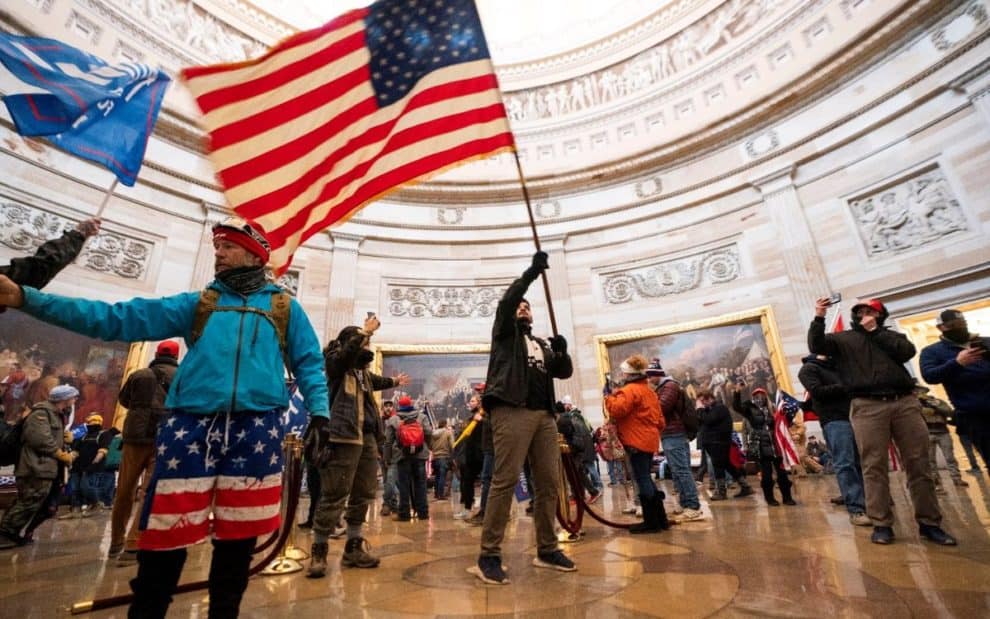Outgoing U.S. President Donald Trump called on his supporters to assemble in Washington on January 6 for the “Save America March” to overturn his 2020 presidential election defeat. Trump claims that the election was “stolen.” Addressing his supporters, Trump urged them to “fight like hell” to “take back our country,” before encouraging them to continue their protest at the Capitol, the meeting place of the U.S. Congress and the seat of the legislative branch of the U.S. federal government. What eventually culminated was the occupation and ransacking of the Senate Chamber, the office of House Speaker Nancy Pelosi, and several other areas of the building, as well as the death of four protestors and one police officer.
Even when the riot broke out, the outgoing president not only refused to condemn it, but seemed almost excited by it. Only when threats of impeachment began did he assure the smooth transfer of power to U.S. President-elect Joe Biden on January 20. What is happening in the U.S., from the eve of last November’s election until the landmark January 6 riot, is the visible tip of the iceberg. The U.S. did not reach this point overnight or for no apparent reason.
The U.S. is one step closer to a minor civil war as ideological clashes are intensifying. The American lower and middle classes are beginning to challenge the established order of things. Major ideological changes continue in western societies as a reaction to the 2007-2008 financial crisis, and the pandemic has only accelerated this.
In the 1990s, 1% of Americans held 45% of GDP growth. In the eight years of George Bush (2000-08), 45% became 65%, and in the eight years of Obama it jumped to 93%. This came as the unbearable financial cost of the U.S.’ failed wars in Afghanistan, Iraq and Syria, combined with the collapse of the financial bubble and the remaining profitable segments of the real estate industry, led to the 2007-2008 financial crisis. The financial crisis severely hit Europe as well, thus intensifying the declining course of the West as a whole. However, the EU continues demonstrating that it is a major economic power that provides high living standards and social services to citizens, while such things are on the decline in the U.S. None-the-less, the EU remains a political dwarf.
Dividing social lines across the U.S.’ oppressed classes are now multiple and intertwined: between the working and unemployed, the young and old, urban dwellers and those in countryside, the educated and unskilled, and so on. These gaps strengthen the fragmentation of the U.S.’ social fabric. The consequence at the political level of such fragmentation is the rise of populist movements to power, largely explaining Trump’s accession to the presidency.
The dramatic events on January 6 at the Capitol will be marked as an important date in history as it signifies U.S. dominance in the international system is waning. The U.S. now appears to be on the verge of disintegration, and a country with such characteristics cannot claim to be the world’s leading superpower anymore. This is happening at a time when the prestige and real power of the U.S. is being deconstructed.
Meanwhile, not only Washington’s adversaries, but also many of their allies outside of the NATO structure, are continuing their path of economic growth and prosperity. Among other things, the inability of the U.S. and Europe to manage the COVID-19 pandemic is in stark contrast to the way in which China, Japan, South Korea, Singapore and other countries have managed to control the problem. And this is not just a matter of prestige. China has managed to minimize the effects of the pandemic on its economy, thus accelerating the closure of the gap it has with the U.S. It is now almost certain that in a few years China will have economically overcome the U.S.
Even in the supposedly privileged area of U.S. domination – military power – developments in recent years show that the Chinese model is rapidly advancing. By creating “defensive bubbles,” China has made it almost prohibitive, or at least difficult, for the U.S. military to operate in areas critical to Beijing. The U.S. was forced to adopt similar battle plans, such as the Multi-Domain Battle, so that they could deal with China’s defensive grids.
The September 11, 2001 downing of the Twin Towers in New York, and now the “invasion” of the Capitol by protesting Americans on January 6 point to major shifts in the geopolitical balance in the early 21st century. The internal division in American society manifested itself both electorally and on the streets. Everything shows, in fact, that there will be a continuation of disintegration in the U.S., and perhaps we are living the very last days of Washington’s so-called world leadership.
After all, even when the incidents broke out, the outgoing president not only refused to condemn them, but provoked it, which has only deepened the many divides that are now dominating the U.S. domestically. With the U.S. weakening internally, it will only naturally weaken it globally. With the U.S. increasingly distracted by events at home, it allows superpowers China and Russia, as well as many regional powers like Iran and Turkey, the space to look more assertively abroad, thus ensuring that the short-lived unipolar order that emerged after the collapse of the Soviet Union in 1991 remains in the pages of history.
Paul Antonopoulos, an independent geopolitical analyst
